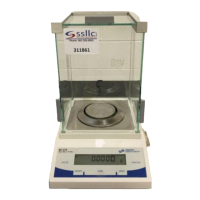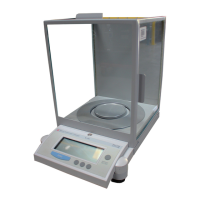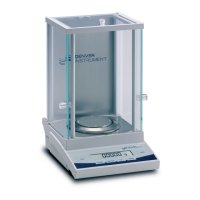Do you have a question about the Denver Instrument TB-215D and is the answer not in the manual?
Guidelines for safe storage and transport of the balance to prevent damage.
Instructions for assembling the weighing chamber and components for analytical balances.
Steps for connecting power, peripherals, and leveling the balance.
Duration required for warm-up and configuration of power-on/standby behavior.
Using the taring function and understanding the self-test process.
Basic weighing process, toggling, and selecting mass units.
Selecting display increments to best meet individual accuracy requirements.
Steps for performing automatic internal calibration using the balance's built-in weight.
Steps for calibrating the balance using certified external calibration weights.
Obtaining weight readouts as a percentage of a reference weight.
Toggling between percent/gram readouts and resetting the reference weight.
Using the program to convert weights into piece counts based on a sample.
How to change the reference sample quantity for counting.
Averaging weights automatically for live animals or unstable conditions.
Manually starting each weighing operation for averaging.
Storing tare weights and determining net weight for multiple samples.
Options for printing individual components or total tare weight.
Adjusting the balance to environmental conditions for optimal performance.
Choosing between standard and manual filling modes for readouts.
Setting the stability symbol display criteria for weight variation.
Defining when the taring operation is performed (any time or stable readout).
Enabling auto zero function and managing menu access via switch.
Options to block or allow access to balance keys for security.
Instructions for using the port for weighing samples below the balance.
Guidance on fastening an antitheft locking device for toploading balances.
Details about the data interface port and connecting peripherals.
Electrical considerations and precautions for connecting devices to the balance.
Configuration of baud rate, parity, and stop bits for serial communication.
Selection of handshake methods for controlling data flow.
Settings to control when and how data is printed or outputted.
Options for auto print, interval output, and automatic taring with data output.
Using code letters to identify data types in output.
Setting up the balance for ISO/GLP compliant printouts and records.
Explanation of command structure and character types for controlling the balance.
Using upper-case, lower-case, and special character commands for balance control.
Guidelines for professional servicing and safe cleaning of the balance.
Procedures for checking AC adapter and ensuring safe operation.
List of optional accessories for the balance.
Procedures for product registration and obtaining service under warranty.
Step-by-step guide to changing balance menu codes.
Procedure to undo all menu code changes and restore factory settings.
| Capacity | 210 g |
|---|---|
| Pan Size | ø 80 mm |
| Power Supply | AC adapter |
| Readability | 0.001g |
| Repeatability | ±0.0001 g |
| Weighing Units | g, oz, ozt, dwt, ct, gn |
| Interface | RS232 |
| Linearity | ±0.1 mg |











